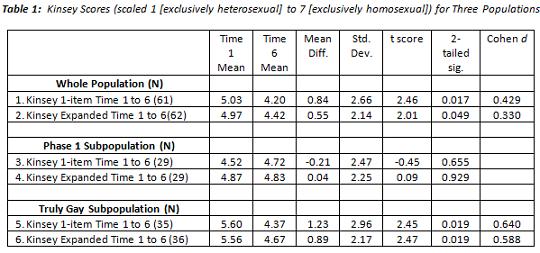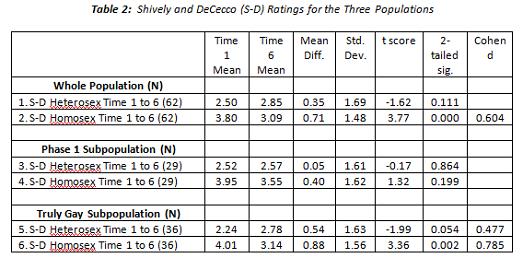In light of conversations on the Exodus-PFOX thread, I thought it might be good to review a past mainstream media article that brought SIT more into the mainstream conversation.
The LA Times article now titled “Approaching agreement in debate over homosexuality” by Stephanie Simon (now with the Wall Street Journal) was published on June 18, 2007 with the title, “New ground in debate on ‘curing’ gays.”
The article begins with some familiar ground to this blog:
Alan Chambers directs Exodus International, widely described as the nation’s largest ex-gay ministry. But when he addresses the group’s Freedom Conference at Concordia University in Irvine this month, Chambers won’t celebrate successful “ex-gays.”
Truth is, he’s not sure he’s ever met one.
With years of therapy, Chambers says, he has mostly conquered his own attraction to men; he’s a husband and a father, and he identifies as straight. But lately, he’s come to resent the term “ex-gay”: It’s too neat, implying a clean break with the past, when he still struggles at times with homosexual temptation. “By no means would we ever say change can be sudden or complete,” Chambers said.
His personal denunciation of the term “ex-gay” — his organization has yet to follow suit — is just one example of shifting ground in the polarizing debate on homosexuality.
I am not sure if I am correct, but I think Alan later nuanced the remarks about not knowing ex-gays, but I do think he has made efforts including the recent article regarding Bryce Faulkner, to paint an accurate picture of his personal situation.
This article brought to a wide audience conversations that we have been having here for quite awhile — and continue to have. The ex-gay conversation is a recurring one here. Some newer readers may want to review this post (Ex-ex-gay?) and this one ( What does change mean?) and this one (Acceptance and Commitment Therapy).
The LA Times article quoted several people who approved of the framework, including commenter Michael Bussee.
“Something’s happening. And I think it’s very positive,” agreed Michael Bussee, who founded Exodus in 1976, only to fall in love with another man — a fellow ex-gay counselor.
Now a licensed family therapist in Riverside, Bussee regularly speaks out against ex-gay therapies and is scheduled to address the Ex-Gay Survivor’s Conference at UC Irvine at the end of the month.
But Bussee put aside his protest agenda recently to endorse new guidelines to sexual identity therapy, co-written by two professors at conservative Christian colleges.
Other notable folks gave a thumbs-up to the framework as well.
He and other gay activists — along with major mental-health associations — still reject therapy aimed at “liberating” or “curing” gays. But Bussee is willing to acknowledge potential in therapy that does not promise change but instead offers patients help in managing their desires and modifying their behavior to match their religious values — even if that means a life of celibacy.
“It’s about helping clients accept that they have these same-sex attractions and then allowing them the space, free from bias, to choose how they want to act,” said Lee Beckstead, a gay psychologist in Salt Lake City who uses this approach.
The guidelines for this type of therapy — written by Warren Throckmorton of Grove City College and Mark Yarhouse of Regent University — have been endorsed by representatives on both the left and right. The list includes the provost of a conservative evangelical college and the psychiatrist whose gay-rights advocacy in the 1970s got homosexuality removed from the official medical list of mental disorders.
“What appeals to me is that it moves away from the total polarization” common in the field, said Dr. Robert Spitzer, the psychiatrist.
“For many years, mental-health professionals have taken the view that since homosexuality is not a mental disorder, any attempt to change sexual orientation is unwise,” said Spitzer, a Columbia University professor.
Some therapies are widely considered dangerous, and some rely on discredited psychological theories. “But for healthcare professionals to tell someone they don’t have the right to make an effort to bring their actions into harmony with their values is hubris,” Spitzer said.
Just over two years later, we continue to discuss very similar concerns and the tension remains.
Activists on both sides caution that the rapprochement only goes so far.
Critics of Exodus note the group still sponsors speakers who attribute homosexuality to bad parenting and assert that gays and lesbians live short, unhappy lives.
And though Chambers has disavowed the term “ex-gay,” his group’s ads give the distinct impression that it’s possible to leave homosexuality completely behind.
Haven’t we just been discussing this topic?
The article concludes with a reference to the APA Sexual Orientation Task Force.
The American Psychological Assn. set up a task force this spring to revise the group’s policy on sexual orientation therapy. The current policy is a decade old and fairly vague; it states that homosexuality is not a disorder and that therapists can’t make false claims about their treatments.
The new policy, due early next year, must help psychologists uphold two ethical principles as they work with patients unhappy about their sexuality: “Respect for the autonomy and dignity of the patient, and a duty to do no harm,” said Clinton Anderson, the association’s director for lesbian, gay and bisexual concerns. “It’s a balancing act.”
In fact, the Task Force will report soon, in August, sometime during the APA convention. Stay tuned…
Although we will soon migrate the website, more on the SIT Framework is now here.


